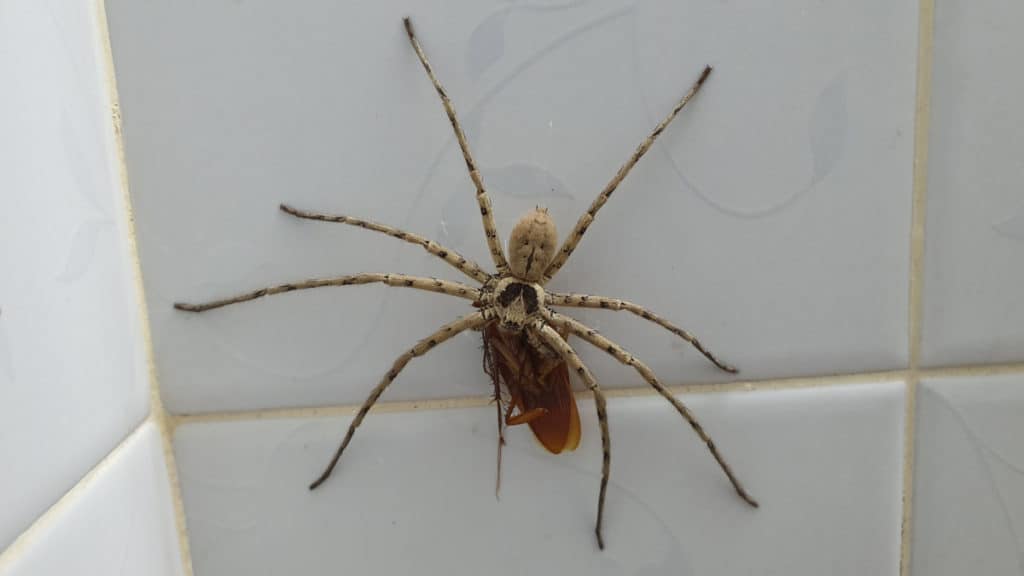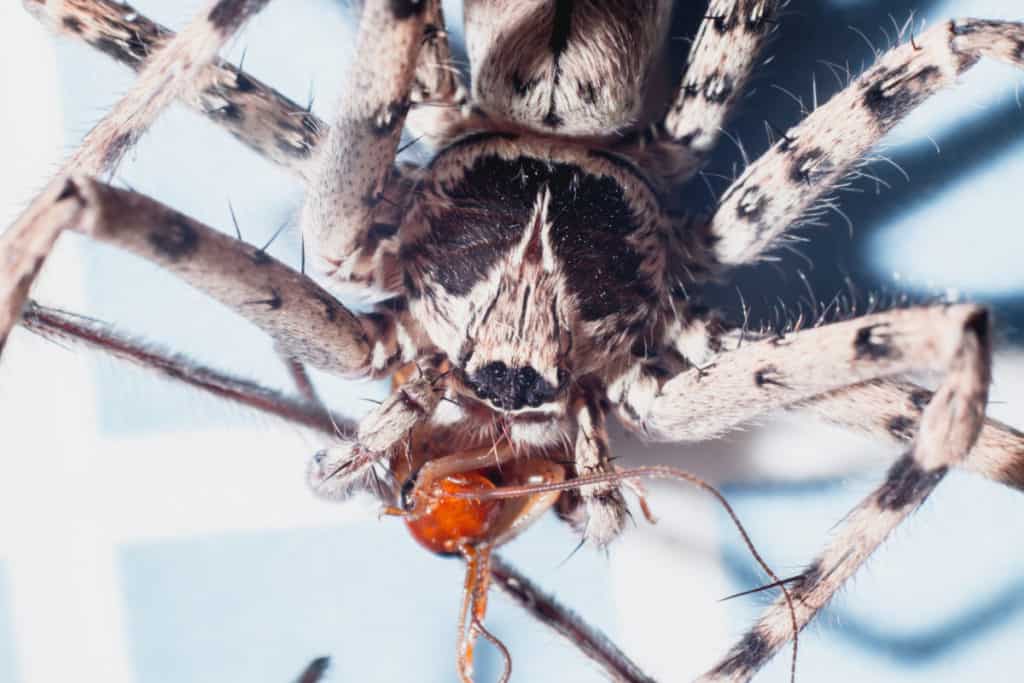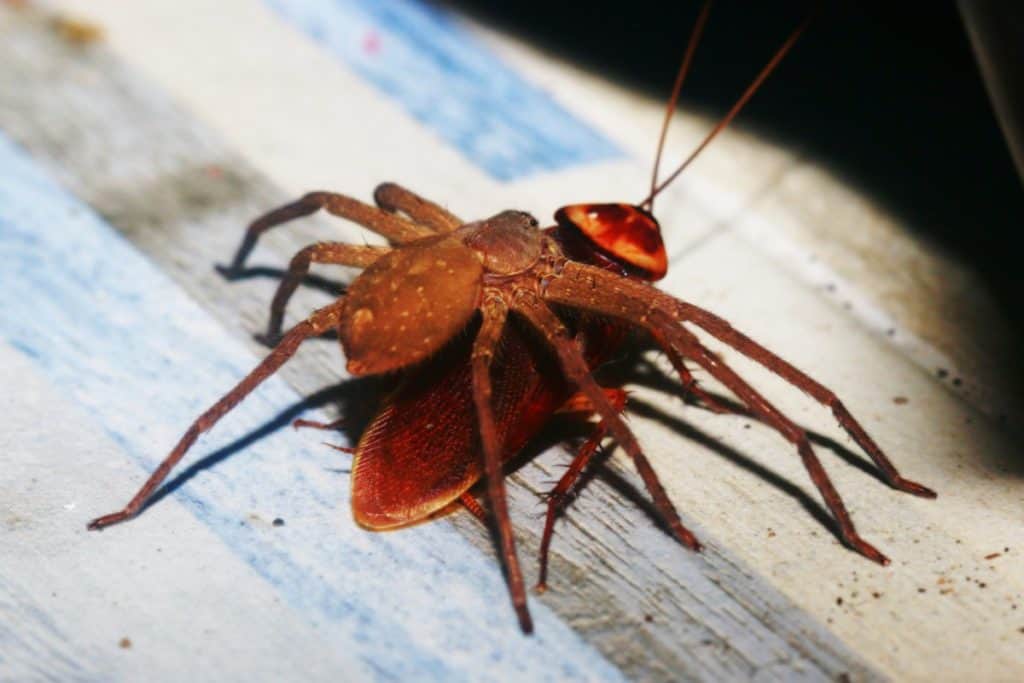Spiders despite being widely depicted as scary and dangerous pests, the majority of species are harmless and are an important exterminator of pesky household vermins such as roaches.
Yes, some species of spiders do feed on cockroaches. In the tropics, they are especially valued because they keep roaches in check. The huntsman spiders and Black widow spiders are among the best of them.
In this post, we will look at how these spiders hunt, subdue and eat roaches.
Huntsman Spiders (Family: Sparassidae)
Huntsman spiders are also known as giant crab spiders because of their size and appearance. On average, their leg span can reach up to 15 centimeters. They derive their name from their speed and mode of hunting. They can be found in many homes and their speed and mode of hunting allows them to commonly hunt and eat roaches.

Huntsman spiders don’t build webs but hunt and forage for food. Small skinks and geckos are part of the huntsman’s prey among other insects and invertebrates such as worms, centipedes, and millipedes that occur in the wild. In the outdoors, they can be found in forests, woodpiles, wooden shacks, and mine shafts.
Huntsman spiders are nocturnal, meaning they are most active at night when roaches are also busy looking for food. Huntsman spiders have an unusual leg arrangement in that they sit away from the body, giving them a crab-like appearance, hence their alternative name giant crab spiders.
They are very fast and their leg arrangement enables them to run sideways. Some of the biggest spiders can cover up to 5 meters per second with their springing jumps while running. They can walk on walls and even ceilings. They are able to squeeze through surprisingly small cracks and crevices due to their flattened body.
How Do Huntsman Spiders Catch Cockroaches?
Huntsman spiders hunt down cockroaches at night when both prey and hunter are most active. Speed is the spiders’ real asset in their hunting forays. They can chase roaches and follow them right into crevices and cracks, reducing the chances of the roaches escaping. They bite and inject venom to immobilize and subdue their prey.

They then pulse digestive enzymes into the roach which turns it into liquefied form. After which they feed on the prey by sucking up the tenderized slurry.
Black Widow Spiders (Family: Theridiidae)
The Black widow spiders come next in line of roach eaters. This spider’s scientific name is Latrodectus and often occurs outdoors but can find its way into houses. Widow spiders construct large webs of tangled, irregular, sticky silken fibers.
They can be found nesting near the ground in dark and undisturbed areas. They prefer small holes dug by animals, or around woodpiles and construction openings. Indoor nests occur in dark places such as in basements, under decks, or under furniture where there is no disturbance.
How Do Black Widow Spiders Catch Cockroaches?
The black widow spider catches prey on its web and frequently hangs upside down near the center of its web and waits for insects to blunder in and get ensnared. Then before the insect can free itself, the spider rushes over to inject it with venom and wrap it in silk.
To consume the prey, the spider first spews regurgitated digestive enzymes over the prey to liquefy it and then proceeds to suck up the predigested slurry into its mouth.
How Do Spiders Kill Cockroaches?
All spiders in the family Sparassidae use venom to immobilize and kill roaches. They inject venom from glands situated in their cephalothorax (fused head and thorax of spiders). They have fangs in their mouthparts (Chelicerata) that connect to the venom glands.
The exception, though, is a unique species belonging to the family Uloboridae that are known as Cribellate weavers or hackled orb weavers. These spiders are non-venomous. A cribellate is feathery, fuzzy silk (hackled silk) and is produced by all members of the family Uloboridae.
The orb woven has a zigzag pattern through the center which is called stabilimentum. The function of this structure is not yet fully understood.
These spiders have evolved a specialized trait that involves wrapping up their prey in silk, then proceeding to regurgitate digestive enzymes onto the prey. These digestive juices predigest the prey and turn it into liquid, the spider then sucks up the food through their straw-like mouths.
Can Spiders Eat Roaches That Are Bigger Than They Are?
Spiders are certainly capable of killing cockroaches that are bigger than themselves. The huntsman spiders are big and fast; their ability to run sideways in any direction gives them a huge advantage when chasing prey. Once the prey has been caught and subdued with venom, it has no chance of getting away.

The orb-weaver spiders wrap their prey in silk and there is no escaping for the victim once they are covered in digestive enzymes. The widow spider’s venom, as earlier mentioned, is harmful even to vertebrates such as humans.
Cockroaches hardly stand a chance against these formidable hunters, size notwithstanding. Female widow spiders have unusually large venom glands.
They are notorious for their bites although they rarely cause death or produce serious complications, the bites can prove to be harmful to animals and humans. Once subdued and predigested with digestive enzymes outside of the body, the spiders can eat the roaches to their fill.
Can Spiders Control An Outbreak Of Cockroaches In Your Home?
Spiders can control an outbreak of cockroaches only to a certain extent because roaches can breed quickly under the right conditions. At the initial stages of infestation, the spiders may probably be able to eat enough roaches to keep their numbers down.
But, if the spiders can’t keep up with the cockroaches in terms of breeding to be able to adequately maintain the balance, they soon become overwhelmed.
At this point, it is a good idea to look into other pest control methods.
Will Spiders Eat Dead Cockroaches?
Most spiders hunt or trap prey in webs or orbs that they spin and weave. Daddy longlegs spiders trap prey on their webs, but they are not averse to eating dead organisms. They also feed on bird droppings and can be found in undisturbed areas such as cellars, high corners, and attics where they construct their messy and irregular-shaped webs.
Unlike other spider species, harvestmen who belong to the Opiliones Order, do not have a sucking stomach or filtering mechanism. This means they can’t suck up slurry as other spiders do. Instead, they ingest tiny particles of food which include dead insects and roaches featured on their menu.
For a complete guide to the diet of spiders you can check out this article we have written, What Do Spiders Eat?
What Other Bugs Will Eat Cockroaches In Your House?
Not many natural predators of roaches can be found in your house. Certain large beetles, centipedes, and parasitic mites feed on roaches. Some types of ants will eat cockroaches when they come across them in confined spaces where they cannot escape.
Because roaches move more quickly than ants, they can be trapped and surrounded by ants. Types of ants that will consume roaches include the invasive red imported ant (RIFA), argentine ants (black sugar ants) as well as other fire ants.
Apart from spiders, the most formidable predator of roaches is the parasitoidal wasp which is a specialized natural predator. There are over 130 species that occur in the tropics, sub-tropics; from Africa, Asia, and Europe. Anywhere that cockroaches exist, the parasitoidal wasp can be found.
A parasitoid is an organism that lives is associated with its host at the host’s expense. This association eventually results in the host’s death. One genus of wasps known as Ampulex belonging to the family Ampulicidae is known to typically inject venom into the cockroach. The venom subdues and immobilizes the roach. The wasp then proceeds to lay one to two eggs between the legs of the defenseless victim.
Ampulex wasps sting nerve centers in the roaches thorax, causing temporary paralysis. This allows the wasp to deliver a sting into the roach’s brain that incapacitates it. The wasp clips the antennae with its mandibles and drinks some hemolymph (blood) before dragging the roach to a burrow, where it lays an egg on the subdued living cockroach.
Another wasp that specializes in roaches is called Evania Appendigaster in the family Evaniidae. It occurs throughout the tropics and sub-tropics and in numerous temperate regions. This is one of the larger ensign wasps. It attacks the cockroaches’ oothecae (the egg case) to lay a single egg inside. When eggs hatch, the larvae feed on the roach.
The Wrap Up
Roaches provide a rich source of proteins for a myriad of predators and spiders have not been left out. Spiders, especially in the tropics, are appreciated for their role in naturally keeping domestic roaches under control.
They may not totally exterminate the cockroaches but they significantly keep their numbers down. The vast majority of roaches occur outdoors and only a tiny fraction,( 30 species) can be found in human habitats. How big they become doesn’t faze the spiders that hunt them; venom injected into them is enough to subdue even the biggest of them.
The parasitoidal wasp is pretty much as efficient as the spiders in preying on roaches but doesn’t eat them. Roaches host the wasp’s eggs and upon hatching the larvae feed on the roaches.
If you are looking for other bugs that will eat check out these articles we have written:
What Does A Praying Mantis Eat?
Sources
https://www.google.com/amp/s/www.livescience.com/amp/41428-huntsman-spider.html
https://en.m.wikipedia.org/wiki/Cockroach
https://www.orlandosentinel.com/news/os-xpm-2007-12-16-orsimply16-story.html
